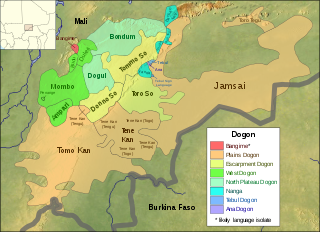Related Research Articles

Southern Bantoid, also known as Wide Bantu or Bin, is a branch of the Benue–Congo languages of the Niger–Congo language family. It consists of the Bantu languages along with several small branches and isolates of eastern Nigeria and west-central Cameroon. Since the Bantu languages are spoken across most of Sub-Saharan Africa, Southern Bantoid comprises 643 languages as counted by Ethnologue, though many of these are mutually intelligible.

The Dogon languages are a small, close-knit language family spoken by the Dogon people of Mali, which is generally believed to belong to the larger Niger–Congo family. There are about 600,000 speakers of a dozen languages. They are tonal languages – most, like Dogul, having two tones; some, like Donno So, having three. The basic word order is subject–object–verb.
The Kadu languages, also known as Kadugli–Krongo or Tumtum, are a small language family of the Kordofanian geographic grouping, once included in Niger–Congo but since Thilo Schadeberg (1981) widely seen as Nilo-Saharan. However, there is little evidence for either classification, and a conservative classification would treat the Kadu languages as an independent family.
Roger Marsh Blench is a British linguist, ethnomusicologist and development anthropologist. He has an M.A. and a Ph.D. from the University of Cambridge and remains based in Cambridge, England. He actively researches and publishes, although he works as a private consultant rather than in academia.
Chakato is a West Chadic language spoken in Plateau State, Nigeria. It was identified by Roger Blench in 2016. It is spoken by about 500 people in one village, Dokan Tofa, which is located on the Jos-Shendam road in Plateau State. Blench (2017) suggests that Chakato may be related to spurious records of the Jorto language. Chakato speakers claim that their language is closely related to Goemai.
The Ubangian languages form a fairly close-knit language family of some seventy languages centered on the Central African Republic. They are the predominant languages of the CAR, spoken by 2–3 million people, and include the national language, Sango. Ubangian languages are generally included in the Niger–Congo family, though this has not been demonstrated, and they may possibly constitute an independent family.
The Digaro (Digarish) or Northern Mishmi (Mishmic) languages are a small family of possibly Sino-Tibetan languages spoken by the Mishmi people of southeastern Tibet and Arunachal Pradesh.
Miju, Midžuish, Southern Mishmi, or Geman languages are a small proposed family of Sino-Tibetan languages spoken by the Kaman people of southeastern Tibet and Arunachal Pradesh. The languages are Kaman (Midzu/Miju) and Zakhring (Meyor). However, whereas Zakhring appears to be Sino-Tibetan, Kaman may be more divergent. Blench and Post (2011) believe that Zakhring is an East Bodish language that has been influenced by Midzu or other divergent languages of the region, whereas Kaman may be a language isolate.
The Mumuye–Yendang languages are a group of Savanna languages spoken in eastern Nigeria. They were labeled "G5" in Joseph Greenberg's Adamawa language-family proposal.
Ukaan is a poorly described Niger–Congo language or dialect cluster of uncertain affiliation. Roger Blench suspects, based on wordlists, that it may be closest to the (East) Benue–Congo languages. Blench (2012) states that "noun-classes and concord make it look Benue-Congo, but evidence is weak."
The 24 East Kainji languages are spoken in a compact area of the Jos Plateau in Nigeria, near Jos. They are poorly studied.
Ana Dogon, or Ana Tiŋa, is a recently discovered Dogon language spoken in Mali. It was first reported online in 2005 by Roger Blench.
The Tebul language, Tebul Ure, is a Dogon language spoken in Mali by the Tebul U. It was first reported under this name online by Roger Blench, who reports that it appears to be the same as a language called Oru Yille in the literature. That name is an error; it means 'two words' in the Tebul language.
The Koma language is a member of the Duru branch of Savanna languages of Cameroon. Blench (2004) includes three varieties separated in Ethnologue, Koma Ndera, Gɨmne, and Gɨmnɨme; within Koma Ndera, speakers of the marginal dialects, Gomnome and Ndera, can scarcely understand one another, though both understand the central dialect, Gomme.
Kutin is a member of the Duru branch of Savanna languages. Most Nigerian speakers moved to Cameroon when the Gashaka-Gumti National Park was established.
The Kimba language, Tsikimba, is a Kainji language of Nigeria spoken by the Kambari people. As of 2004, the language had 100,000 native speakers.
The Siangic languages are a small family of possibly Sino-Tibetan languages spoken in Arunachal Pradesh, northeast India. The Siangic languages consist of Koro and Milang.
Duli is an extinct Adamawa language of northern Cameroon. Blench (2004) links it to the extinct Gey (Gewe) language; Glottolog states that Gey is undemonstrated as a distinct language.
Lere is a nearly extinct Kainji dialect cluster of Nigeria. The ethnic population was cited as 16,000 in 2000, of whom only a few speak the language. A wordlist from the Takaya dialect can be found under External links.
References
- ↑ Dowayo at Ethnologue (18th ed., 2015)
- ↑ Hammarström, Harald; Forkel, Robert; Haspelmath, Martin, eds. (2017). "Doyayo". Glottolog 3.0 . Jena, Germany: Max Planck Institute for the Science of Human History.
- Roger Blench, 2004. List of Adamawa languages (ms)
| This article about Atlantic–Congo languages is a stub. You can help Wikipedia by expanding it. |